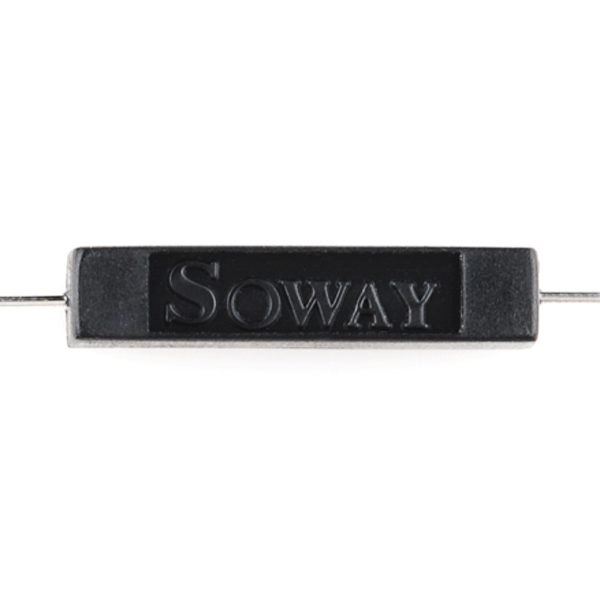This is a small device called a reed switch. When the device is exposed to a magnetic field, the two ferrous materials inside the switch pull together and the switch closes. When the magnetic field is removed, the reeds separate and the switch opens. This makes for a great non-contact switch.
This reed switch can be populated easily on a PCB and is encapsulated so it's more durable than glass reed switches.
Need a custom board? This component can be found in SparkFun's À La Carte board builder. You can have a custom design fabricated with this component - and your choice of hundreds of other sensors, actuators and wireless devices - delivered to you in just a few weeks.
- Contact Form: SPST
- Operate Range: 20 AT to 25 AT
- Color: Black
- Mounting Style: PCB Mount
- Termination Style: Axial
- Contact Position: Normally Open
- Maximum Operating Temperature: + 105 C
- Minimum Operating Temperature: - 40 C
- Capacitance: 0.3 pF
- Current - Carry: 800mA (DC)
- Current - Switching: 350mA (AC), 500mA (DC)
- Voltage - Switching AC: 140 V
- Voltage - Switching DC: 200 V
- Power - Rated: 10W
- Operate Time: 1 ms
- Release Time: 1 ms
- Length - Overall: 1.590" (40.39mm)
- Size - Body: 0.630" L x 0.095" W x 0.095" H (16.00mm x 2.40mm x 2.40mm)
Reed Switch - Insulated Product Help and Resources
Reed Switch Hookup Guide
May 5, 2016
Magnetically-actuated reed switches are the perfect component for non-contact proximity sensors. This tutorial provides a quick overview and example hook up.
Button and Switch Basics
May 7, 2013
A tutorial on electronics' most overlooked and underappreciated component: the switch! Here we explain the difference between momentary and maintained switches and what all those acronyms (NO, NC, SPDT, SPST, ...) stand for.
Core Skill: Soldering
This skill defines how difficult the soldering is on a particular product. It might be a couple simple solder joints, or require special reflow tools.
Skill Level: Noob - Some basic soldering is required, but it is limited to a just a few pins, basic through-hole soldering, and couple (if any) polarized components. A basic soldering iron is all you should need.
See all skill levels
Core Skill: Electrical Prototyping
If it requires power, you need to know how much, what all the pins do, and how to hook it up. You may need to reference datasheets, schematics, and know the ins and outs of electronics.
Skill Level: Competent - You will be required to reference a datasheet or schematic to know how to use a component. Your knowledge of a datasheet will only require basic features like power requirements, pinouts, or communications type. Also, you may need a power supply that?s greater than 12V or more than 1A worth of current.
See all skill levels
Comments
Looking for answers to technical questions?
We welcome your comments and suggestions below. However, if you are looking for solutions to technical questions please see our Technical Assistance page.
Customer Reviews
No reviews yet.




The switch isn't releasing when the magnet is removed with just 75mA load on it. It works when checked with a DMM but doesn't work in the circuit and ideas why this would be? If I'm reading the datasheet right it should be able to switch up to 250mA
Any chances it will be back in stock soon? Thanks.
Thanks! Now P-MOSFETs are gone =(
Is this a molded body package, or a glass reed switch inside of a plastic body?
I didn't know so I cut one open. It seems to be just a glass reed switch inside a plastic body. So, the same reed switch you know and love, but with a more durable body.
Can this switch be set up for when it is in a magnetic field, the switch is "off" and vice versa? I guess its called what a normally closed switch? Or do they make such reed switches?
You can get reed switches that are open with the magnet nearby. They have a little lever inside the tube. The magnet needs to be stronger, though. When you look for reed switches (sometimes called magnetic switches) some manufacturers call them "Normally Open" when the magnet is nearby, other manufactures call them "Normally closed" when the magnet is not nearby (the same switch!). So you have to be careful to get what you need.
I'm guessing that a PNP/pMOS transistor would accomplish this far more effectively than a reed switch of greater complexity. The PNP/pMOS transistor performs a logical inversion - thereby switching off when the reed switch is closed (conducting), and switching on when the reed switch is open ("off").
Sparkfun (and every reputable electronics supplier) carries both.
PNP Bipolar-Junction Transistors: https://www.sparkfun.com/products/522
p-Channel MOSFET (pMOS): https://www.sparkfun.com/products/10349
the MOSFETs are better for higher current applications, but (speaking only for myself) are more slightly less intuitive for a beginner.
how powerful do the magnets need to be for this reed switch to work well?
I just got a couple of these this week and did a quick test. With the .125 inch magnet squares I have to be about a quarter of an inch or less away from the reed switch for it to activate. With a magnet out of an old hard drive (quite a bit larger than the magnet square) it was around an inch.
Can't find any information on the operating-distance (must operate, must release) of the sensor on the Datasheet or anywhere online. Maybe someone has practical experience and can estimate those values??
OMG - THANK YOU. I've broken so many glass reed switches, I was ready to start implanting magnets in my finger tips to trigger my devices. THANK YOU!!!!
Yep, I'm in the same boat. I broke no less than 5 installing them into a project that only required 1.
Perfect example of Murphy's Law.
How many times can these be switched before they wear out and need to be replaced? And how "bouncy" are these? the datasheet is VERY vague.
The materials are likely to degrade before they wear out. They should be debounced, but they shouldn't be excessively bouncy unless you're using an under-strength magnet.
Are you going to incorporate this reed switch into the sensor kit you have or keep selling it with the normal glass reed switch. I feel you should due to durabilities sake.
good idea. we'd need a more reliable supply, but that's worth considering for sure. thanks.